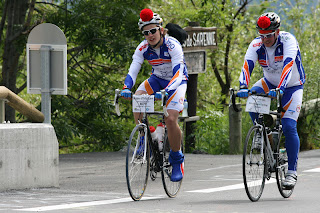Leaving Annecy we had a relatively short drive to our hotel in the village of
Huez on the slopes of Alpe d'Huez. We stopped off for a break and some lunch in the town of
Chambery which is situated in the Rhone-Alpes region of France, it is the capital of the Savoie region. It lies in a valley in the Alps surrounded by the Bauges and Chartreuse mountain ranges and on a clear day provides almost 360-degree view of the French Alps.
 |
| Downtown Chambery |
Next stop Alpe d'Huez. When we reached what would be the start point for the climb up the mountain we got a clear understanding of what lay ahead. This time by car, two days later it would be on the back of a bike, daunting for the two of us who had never cycled up nor down (equally daunting and a lot faster) such a mountain. Once you hit the first bend the gradient increases dramatically and from then on it just keeps going for over 14kms, in all you encounter 21 switchbacks or hairpin bends, all of which are numbered so that you can count them down as you climb. Our reaction when we got to our hotel and met some of the early arrivals was "Oh my god", actually it was stronger that that.
 |
| Our hotel in Huez village, Hotel L'Ancolie |
Our home for three nights was the
Hotel L'Ancolie (
www.ancolie-hotel.com) in the sleepy village of Huez en Oisans. The following morning we went for a training ride to climb up to the village of
Les 2 Alpes which will be familiar to those of you who ski. This was a great day as it gave the unexperienced, like us, an understanding of what we would encounter the next day. Most importantly it gave us some experience of how to descend a steep mountain, you won't believe the speeds that the professionals and serious amateurs descend at, it's amazing.
 |
| Training day - Team Photo |
The following morning the experienced and highly motivated part of the team descended the mountain in the dark to give them the best chance to climb the Alpe 6 times, Zes keer in Dutch. We departed a little later just to make sure we made it down in one piece to give us the chance to make it to the top.
 |
| Time to go..... |
What followed was an amazing day, its an experience which all of us who took part will never forget. The event
Alpe d'HuZes is huge in the Netherlands with around 4,000 participants and 15,000 supporters lining the mountainside and the route into town to cheer the cyclists on. The event raises money to support the care for those suffering from cancer and raised over
20m Euro which is a staggering amount. Many of the participants have been impacted in some way by the terrible curse that cancer is, so the day itself is highly emotional and there are candles at every corner to commemorate those who didn't win their battle against the disease. What follows are some photos which hopefully give you an idea of what a great experience we were lucky enough to take part in.
 |
| Celebratory kiss xxx |
 |
| Once you're up, you have to go back down |
 |
| Team HQ, relaxation area |
 |
Time for a biere
|
The scale and success of
Alpe d'HuZes seems to grow on an annual basis, so much that in
2012 the demand to take part is so big that the event will take part over two days. If you know someone taking part in the event be sure and support them financially, their commitment is their time and effort, your money will go to a very worth cause. For both of us in
2011 the experience was fantastic, for our team members who climbed the mountain 6 times (Zes keer) an amazing achievement,





























































